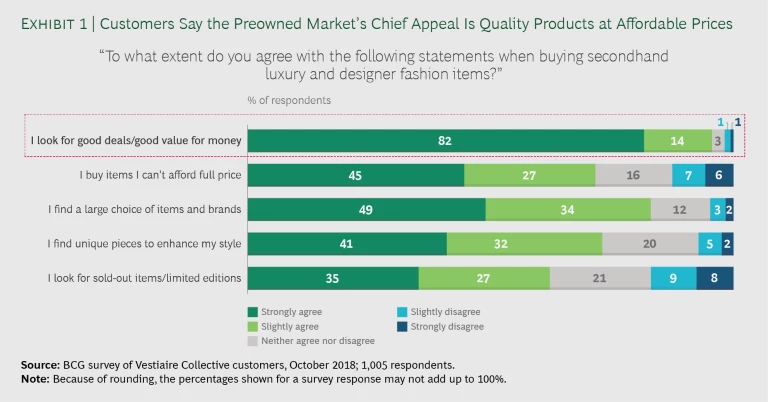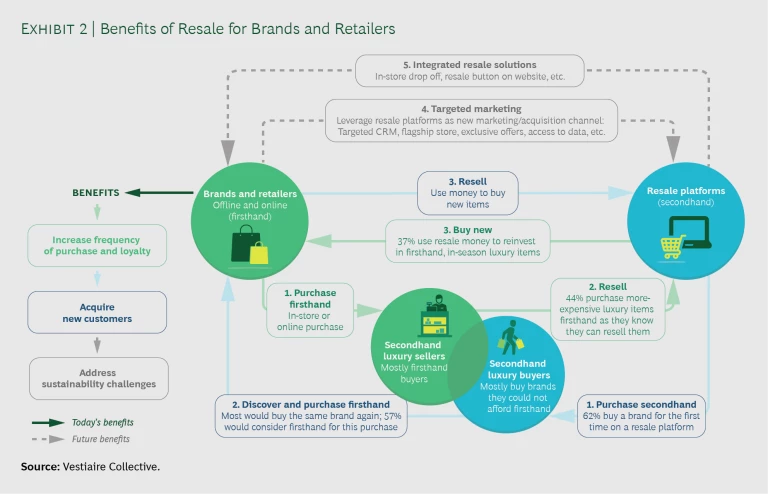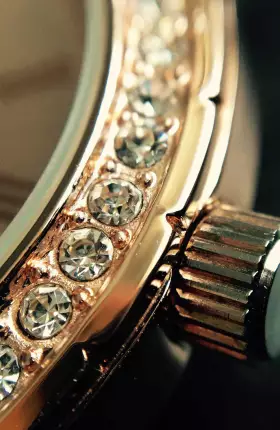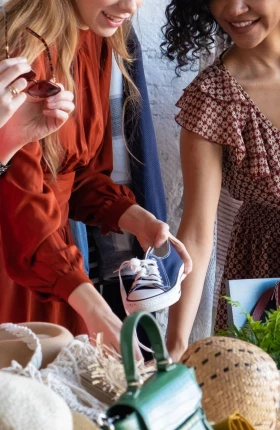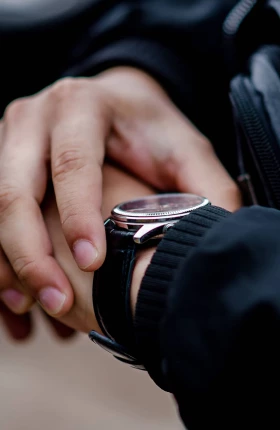This article describes the results of an October 2018 BCG survey of 1,005 Vestiaire Collective customers and the 2019 BCG-Altagamma True-Luxury Global Consumer Insight study, which surveyed more than 12,000 consumers in ten countries.
Luxury goods manufacturers have much to gain by encouraging and participating in the fast-growing luxury resale market. Although many manufacturers once viewed this market as an unattractive niche, a recent BCG survey reveals that it has found new life through the online channel and now offers a powerful opportunity for luxury brands to boost their image and grow their customer base.
The secondary market has always been a steppingstone into the luxury world for customers who don’t have access to the primary market. Online sales have accelerated this effect, as more and more customers who may one day become primary-market luxury clients discover that it offers an avenue to goods they didn’t think they could afford. These resale customers typically are not primary-market buyers—and therefore tend not to be secondhand sellers. Instead, sellers are usually firsthand buyers who use resale to get money back so they can reinvest in new, full-priced luxury products.
In addition, a thriving resale market makes the luxury industry more sustainable—and more popular with environmentally aware millennials—by supporting a circular luxury economy. Brands that go further and actively collaborate with the preowned market can secure a number of previously unforeseen benefits, including the ability to connect with their customers in an innovative way.
A Boom in Resale
The secondary market for luxury goods has always existed in the shadow of the primary market, but now it’s moving into the spotlight, becoming one of the fastest-growing areas of luxury. This market niche is expected to grow from an estimated $25 billion in revenues in 2018 to around $36 billion in 2021, increasing by an average of 12% per annum and boosting its share of total personal luxury goods to around 9%, according to the 2019 BCG-Altagamma True-Luxury Global Consumer Insight study , which surveyed more than 12,000 consumers in ten countries. The primary luxury market, in contrast, is expected to grow more slowly over the same period, at around 3% per annum.
The secondary market is expected to grow from an estimated $25 billion in revenues in 2018 to around $36 billion in 2021.
Much of the growth in resale will come from online platforms, which currently generate around 25% of global secondhand luxury-market sales, according to BCG research. Small, independent stores that worked on consignment once dominated the resale market—and we expect this mature offline retail channel to remain highly fragmented, with slow growth for independent stores, which tend to lack a luxury look and feel.
In sharp contrast to that sales model, online retailers are concentrated and organized, offering large catalogs of goods, price transparency, home delivery, and even repairs to ensure that products are in good condition. Further fueling growth, a number of new specialist online players are emerging, and generalist online platforms are expanding to include luxury goods.
Among individual secondhand luxury segments, leather goods such as handbags are extremely popular, as they are an aspirational product for first-time buyers, easy to buy online, and yet relatively scarce in the traditional offline retail channel. Most firsthand luxury goods companies have a vested interest in this category because leather goods are typically their primary focus—and in many cases account for the bulk of their sales. The watches and jewelry segment is also well developed. Meanwhile, clothing and shoes make up a relatively small proportion of today’s luxury resale items, as their potential is capped by the typical barriers for online purchase of such goods: the inability to try them on, the wide range of sizes, and, therefore, the risk that they won’t fit.
Looking across geographies, we find that resale is a global phenomenon. Its presence is particularly strong in the US, where 50% of luxury customers—defined as those who have purchased a luxury item in the previous 12 months—participate in the resale market, according to the BCG-Altagamma survey, and in Europe, where the market is developing quickly. The resale market in China is emerging steadily, too, although it is not yet well structured and no large players have appeared.
In terms of generational differences, younger luxury consumers are the largest participants in the secondhand market, with 54% of Generation Z and 48% of millennial luxury customers buying preowned goods. In contrast, just 38% of Generation X luxury customers and 35% of Baby Boomer luxury customers buy secondhand.
Younger luxury consumers are the largest participants in the secondhand market, with 54% of Generation Z and 48% of millennial luxury customers buying preowned goods.
Primary Growth Engines
An October 2018 BCG survey of 1,005 Vestiaire Collective customers and the 2019 BCG-Altagamma survey highlight four main factors behind the growth in luxury resale: price accessibility, the increasing professionalization and concentration of the secondhand market, changing consumer preferences, and access to a broad selection of products.
Price Accessibility
The first major growth engine behind increasing secondhand sales is the ability of customers to gain access to luxury items at affordable prices. Buying and selling in the preowned market allows these consumers to increase their disposable income by limiting their total cost of ownership (TCO). In fact, around 96% of buyers in the BCG-Vestiaire Collective survey say that they purchase secondhand items in part because they are looking for good deals. (See Exhibit 1.)
Growing Professionalization and Concentration
Traditional brick-and-mortar luxury resale includes very few players of significant size. Instead, the market consists largely of a long tail of small businesses that focus on a specific product category or geographic footprint.
Online resale platforms for luxury goods have won over consumers by offering far greater brand selection and product assortment. In addition, each platform has developed its own services and approach, with specific offerings that include product authenticity and curation (Vestiaire Collective, The RealReal); consignment, at-home pickup, photos, and storage (The RealReal, Vestiaire Collective); and category expertise (StockX for sneakers, Chrono24 for watches). Many have upgraded the buyer experience to premium standards, providing websites with a luxurious look and feel. Others are creating offline expansions through brick-and-mortar stores. The RealReal and Rebag, for example, have opened a few physical stores, while Vestiaire Collective has opened pop-up stores at large retailers such as Selfridges and Le Bon Marché.
The willingness of these online resellers to grow and professionalize their offers has not only attracted buyers and sellers into the space, but also drawn sizable venture capital and equity investments, such as the more than $280 million raised in 2018 by The RealReal—a company that went on to raise $300 million in an IPO in June 2019. (See the sidebar.) As such investments continue, they create barriers to entry, boosting market concentration and establishing a few clear winners as a result.
The RealReal
The RealReal
The RealReal (TRR) was the first luxury reseller to go public, in June 2019. The platform, founded by e-commerce entrepreneur Julie Wainwright in 2011, raised more than $350 million in funding before taking the company public. Priced at $20 a share, the IPO then raised $300 million.
The company has experienced strong growth since its founding, generating $207.4 million in revenues in 2018, up 55% over 2017, on $711.0 million in gross merchandise value. The number of orders reached 1.6 million in 2018, up 42% year-on-year.
Changing Consumer Preferences
Another source of growth in the preowned market is shifting consumer preferences. Today, consumers—especially millennials and Generation Z, the market’s largest participants—tend to care more about sustainability and responsible consumption than did prior generations. Our BCG-Altagamma study found that 59% of luxury customers in both the primary and secondary markets say that the issue of sustainability influences their purchasing behavior, while 17% of customers in the secondhand market purchase preowned items because they consider doing so to be “truly sustainable behavior.” Our survey of Vestiaire Collective customers yielded similar data, with more than 70% of respondents saying that they try to shop ethically and 13% saying that sustainability is extremely important to them. Of those that shop ethically, 57% say that environmental impact is their primary concern.
Access to a Broad Selection of Products
The preowned market is also growing quickly because it offers customers a large selection of products. Beyond vintage items and items made available from past luxury collections at affordable prices, two types of items are especially popular on the resale market: rare or iconic items, including limited editions, that suffer from scarcity in the firsthand sales network; and collaborations. Resale prices for the former typically build in a premium that is highly correlated with the items’ desirability and scarcity, sometimes making them more expensive than the same items sold firsthand.
Increasingly, luxury brands are collaborating with artists or other brands. In fact, awareness of such collaborations reached around 90% of survey participants in 2018, and 50% of them had actually purchased collaborations or special editions. Such purchases are most common among Chinese customers (62% of those surveyed) and younger generations of shoppers (67% of Generation Z customers and 60% of millennial customers).
Of the buyers we surveyed, 62% say that they find the preowned market attractive today because they are looking for sold-out items or limited editions (“strongly agree” or “slightly agree”), and 83% point to the large choice of items and brands available there.
Reasons to Support Preowned
Luxury players might understandably regard a growing preowned market as a threat. However, the secondhand market has much to offer the luxury industry, including serving as a recruiting mechanism into the luxury world, encouraging primary-market buyers to purchase additional premium items in light of their lower TCO, and boosting sustainability.
The secondhand market can recruit new buyers into the luxury world, encourage primary-market buyers to purchase additional premium items in light of their lower TCO, and boost sustainability.
Preowned Purchases Are a Recruiting Mechanism
Buyers of preowned luxury items are usually consumers who either don’t have access to the primary luxury market or don’t want to purchase new products at full price. In fact, 71% of the preowned item buyers we surveyed lean toward items and brands that they can’t afford firsthand. The secondhand market is therefore a powerful way for luxury brands to connect with—and anchor their brand in the minds of—buyers who may become primary customers in the future. Social media generated around the preowned market can help, too, by publicizing high-quality products and brands through the comments and feedback that market participants provide and by creating transparency around the products in most demand.
As buyers of secondhand luxury items mature, their purchasing power tends to increase, giving them the financial resources needed to shift to the primary market. When they do, they will already be educated in a given brand or brands and may remain loyal after the transition. Among survey participants, 62% say that their first purchase of a brand they currently like was secondhand on Vestiaire Collective; and within that 62%, almost all of them say that they would consider buying that brand again. Although 43% say that they would probably stick to secondhand, the remaining 57% would either definitely buy or consider buying the item firsthand—making them very good prospects for the firsthand market.
Secondhand Sellers Are Firsthand Buyers
Secondhand sellers typically use resale to regain some of the money they spent on firsthand purchases—often so they can reinvest in new, full-priced luxury products. Of the sellers we surveyed, 32% say that their primary reason for selling was to be able to purchase new firsthand goods. Most sellers of preowned items buy very little in the secondhand market. For example, 70% of all preowned sales on the Vestiaire Collective platform are generated by sellers who rarely purchase secondhand (less than 20% of their transactions are purchases). And these purchases in aggregate represent only 3% of all transactions made on the platform.
As reselling a luxury purchase becomes easier, primary luxury customers are even adjusting the way they buy. Some customers are trading up and buying higher-ticket firsthand items, in anticipation of the lower TCO. Among survey respondents, in fact, 44% say that they purchase more-expensive luxury items than they would have bought without a resale market. Other customers purchase more frequently, investing approximately the same amount on individual items overall, but buying repeatedly as they free up their budgets by reselling used items. Preowned sales clearly boost these sellers’ purchasing power for new items and, therefore, create an opportunity for manufacturers to increase primary-market sales, benefiting luxury players.
Preowned Boosts Sustainability in the Luxury World
The preowned market extends the lifetime of luxury products. Most products sold on preowned luxury platforms are of high quality, with 62% of them unworn or scarcely worn (worn three to ten times), according to our survey.
It also helps create a circular luxury economy, a hot topic in the fashion industry today. As Stella McCartney has said, “If every single second there’s a truckload of fast fashion being incinerated or landfilled, then I’m a big, big, believer in reusing that and [participating in] the circular economy.” And “extending the life of clothes by just nine extra months of active use would reduce carbon, waste, and waste footprints by around 20–30% each,” according to environmental action group WRAP.
Luxury companies that support sustainability can take pride in participating in a more responsible ecosystem, and they will ultimately benefit from such positioning. This is especially true in view of the importance of sustainability to young consumers today, as illustrated by initiatives such as Stella McCartney’s sustainability partnership with The RealReal, along with the Bash and SMCP partnerships with Vestiaire Collective.
In contrast, behaviors such as stock destruction can backfire in the eyes of the younger generation, particularly when these customers are ready to shift to primary luxury. One European luxury goods manufacturer experienced this firsthand, when its customers discovered that it had burned all of the prior year’s unsold products. The company quickly announced a policy change, saying that henceforth it would take a more sustainable path.
Luxury companies that support sustainability will ultimately benefit from participating in a more responsible ecosystem.
A more responsible industry sales ecosystem can also serve as a strong complement to and differentiator from the various ethical and corporate social responsibility (CSR) initiatives that luxury players typically pursue. And it meshes well with the new Fashion Pact introduced by French president Emmanuel Macron at this year’s G7 summit—a set of objectives intended to encourage the fashion industry to reduce its environmental impact. Thirty-two companies, comprising roughly 150 brands, have signed the pact so far, thereby committing to collective achievement of practical objectives in three areas: stopping global warming, restoring biodiversity, and preserving the oceans.
Collaboration Brings Further Benefits to the Luxury Ecosystem
Luxury players that actively support and collaborate with the preowned market can garner even greater benefits. Brands can actively collaborate in several ways. First, they can provide access to a resale service that helps buyers consume more sustainably and supports the circular economy. (See Exhibit 2.) Second, they can create unique or exclusive events and collaborations that mix current and vintage treasures to celebrate a brand’s heritage. Third, they can reinforce the fight against counterfeiting. And fourth, they can work with resale players to engage with a community of advocates and prospective customers.
Such collaborations might enable luxury players to benefit from access to data on purchasing patterns, giving them a better understanding of underlying trends, including potentially collecting insights for the primary market. Alternatively, they might interact with communities of engaged consumers to obtain feedback on products and brand positioning. Any active involvement would also contribute toward eventually converting clients to the primary market.
All of these factors point toward the same conclusion: brands that support the secondhand market—without fearing consumer feedback or competition—are most likely to emerge as winners.


